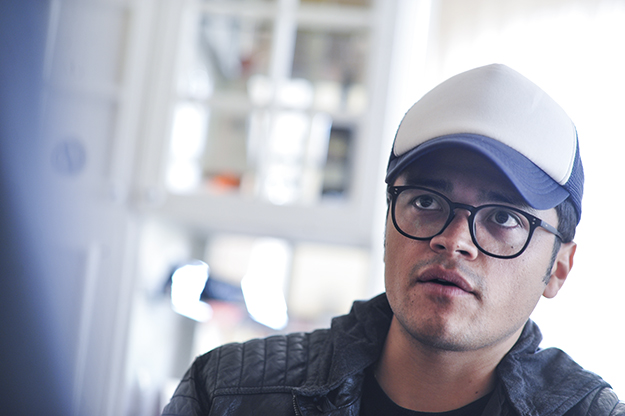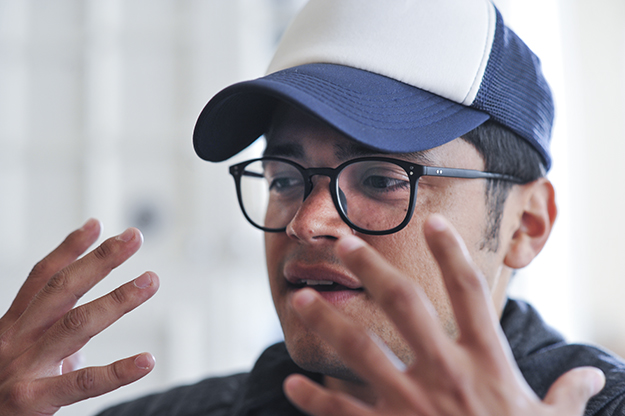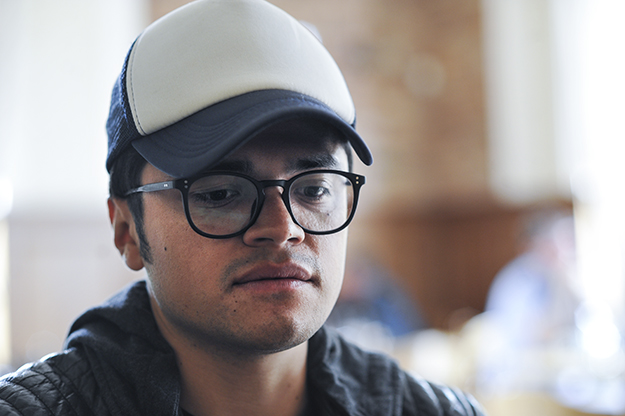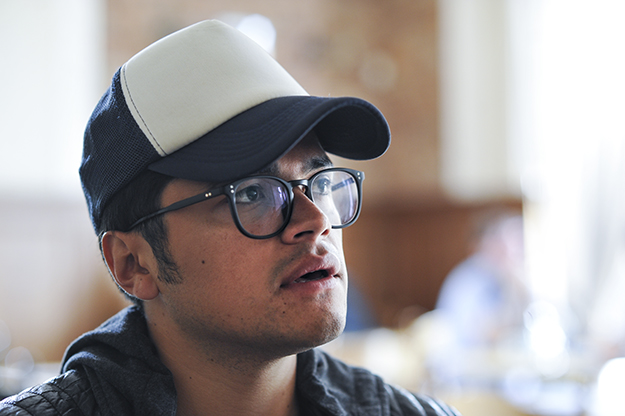Jovanny Varela Ferreyra arrived in the U.S. when he was only 10. Originally from Mexico, his parents told him it was just a short visit to el norte (Spanish for ‘The North’), and back then his knowledge of English was nowhere.
He speaks openly about experiencing social anxiety, bullying episodes and struggling with expressing himself, but he found a tool that allowed him to speak his mind. “When I did not have the social skills I turned to art,” he told a room of nearly 300 people this week in Prishtina. Now, he has turned this skill into a tool for a virtual community of 2 million people, through The Artidote project, which introduces art as a tool for healing in connection with mental health.
Varela Ferreyra was in Kosovo’s capital on Monday (May 14) to give a public presentation about The Artidote as part of Mental Health Week. With a focus on Art Therapy, and organized by the Center for Information and Social Improvement (QIPS), the aim of the week is to raise awareness of mental health related issues through a series of public events, from open discussions, to poetry readings and concerts. (View the full program here.)
The Artidote is a virtual platform, present on social media (Facebook, Snapchat, Instagram, Tumblr, Twitter). Mainly sustained by Varela Ferreyra as a side project (he works as a city tour guide in Munich), The Artidote publishes and disseminates visual artwork combined with meaningful messages; his aim is to make the reader reflect upon it or connect with it, contributing to healing through art — a thoughtful break in the midst of memes, videos about puppies, online rants and images of your social media friends projecting never-ending happiness and their ‘perfect’ lives.

Photo: Atdhe Mulla / K2.0.
Founded in 2015 with the aim of providing a meaningful platform for helping to talk about mental health, emotions and feelings, this online community’s online members are truly worldwide. The stories within it are aimed at accepting and dealing with daily feelings that everyone has gone through, such as frustration or loss. For many, the platform has become a place to interact and connect with others experiencing depression, anxiety and other mental health issues.
K2.0 sat down with Varela Ferreyra to speak about healing through The Artidote.
What does The Artidote offer to people?
I always have to put a huge disclaimer. Sometimes people enter the page and they think — or they have heard of friends that have been helped through depression or anxiety or mental illness through The Artidote — they immediately think that this is a space where you go in and you receive therapy, you receive professional services. Almost everyday I get messages from people who say: “Help me.” I always have to explain what I do and what I don’t do.
My training is arts. I am an artist. The Artidote started as an art project combining artwork and a quote or passages of literature, bringing them together to create emotions or conversations. This somehow shifted into mental health when people begin to feel connected by having very vulnerable conversations that were not specifically talking about mental health as a thing, but it was very much connected to mental health.

Photo: Atdhe Mulla / K2.0.
And that’s what I think is the big challenge — to talk about mental health without [alienating certain people]. When we talk about mental health we’re using terminology from the past and the youth does not connect with that anymore.
For example, I sometimes go in different cities and I have an Artidote meetup. The Artidote meetup is where people from the community come together and we interact, without an agenda or a program. Sometimes it’s six people and sometimes it’s 160 people.
I cannot call that meetup a support group, I cannot use that terminology, because the moment I do, that turns a lot of people off. Because if they go to a ‘support group’ that means that they are broken, that they are getting fixed, and for me that’s the challenge: to talk about mental health and to be useful to people’s mental wellbeing without having that professional terminology — not taking away the importance of the professionals, we need professional assistance. But it’s very difficult to sort of engage, especially the young people, to talk about these issues.
The Artidote community is based and rooted in the social media world. Is social media a ‘happy’ place to meet people?
It really depends. Nothing in the world is a black and white issue, there is much grey area and there are good examples of social media being great for cultural, political and social causes. There are also gonna be some really bad side effects.
"I think of social media as a tool, like a hammer. And you can both build the house with a hammer or smash somebody’s head."
Social media is also relatively very new, but many researchers have already raised concerns about social media in connection with depression and even addiction. It’s also an easy place to get negativity if you surf on it for too long. So is it really the ideal place for one’s mental health, or how can we break the negative thinking within it?
I think our minds are designed to find reasons, and we try to find what the reason is [behind something], and sometimes we go to the immediate thing that we see. But we sometimes even refuse to look at the deeper issue. The more I get involved with what I am doing, the more I realise that social media or cell phones are not the issue. It’s usually something deeper.
I think of social media as a tool, like a hammer. And you can both build the house with a hammer or smash somebody’s head. A lot of people complain that Facebook is causing this distraction, and depression and anxiety, when the more I dig into it, it’s deeper than just having the tool.
[Depression, anxiety, etc.] is something that have to do with circumstances, and the family, the home, and the country, and the city, maybe a collective trauma… really something deeper. It is expressing itself in social media, but it’s also expressing itself in cigarettes, in drugs, addiction… it’s not about being addicted, it’s about having to escape from something that we haven’t really processed. A lot of people use these tools as forms of escapism.
In some of your previous interviews you have said that you identify two types of stories that are propagated in general: stories that propagate messages of love, and stories that propagate messages that connect with fear somehow. How does this play out through The Artidote?
Through The Artidote, love or fear play out in the type of content that I choose [to share]. When I started creating posts that were generating emotions in people, and they were going viral, I felt at first that I had a lot of power to affect somebody’s mood based on what I shared.
All of a sudden I could make somebody feel happy, sad, anxious, and when we talk about social media and the tyranny of the ‘Like’ — wanting people to ‘Like’ your content or to share it — I realized that there was a conflict of interest there, that I was either doing it to grow a Facebook page, or I was doing it for the content itself. So I decided to not do it for the ‘Likes.’

Photo: Atdhe Mulla / K2.0.
For me, it’s really easy to put out a post that talks about heartbreak, that talks about really vulnerable emotions in a very irresponsible manner, which instead of helping people process that heartbreak pushes them more down, where they don’t see a way out. It’s very easy to create content that is just gonna get a lot of ‘Likes,’ or content that’s made out of fear…
And that’s the challenge, to create content that is accepting certain vulnerabilities but that helps moving forward without getting into the positivity bias, which tells us that we should be happy at all times, that if you are not happy you are not being a full human being… but that’s a different cup of tea.
One challenge with negative thinking is also believing oneself’s positive thinking — if I can use these words, our own little ‘counterattack’ to our own negative thoughts, which can easily overwhelm the positives, especially if one is going through a depressive episode, or anxiety, right? Seeing the message from another person, in this case from the community of The Artidote, can it change that? Does it help people believe in something when the message comes somehow from others, as happens within The Artidote?
Yeah. I started this initiative on Snapchat, where you can send a picture with an overlay text on it — people were given the possibility of sharing their thoughts, so they would share them with me and I would share them in the [public] timeline. We just asked for them to share their location and the time when it was sent.
"This is a real problem in our society right now, to have negative vs. positive emotions — because they are all just emotions and we should embrace all of them."
That became one of the pillars of The Artidote, because people started seeing their own struggle, their own stories, their own thoughts in other people. Just the fact that somebody else was going through the same thing… it’s not that it made everything better, but it helped to show that you are not alone.
Sometimes when we feel these negative thoughts we think that we are the only ones feeling this, and that maybe we are not worthy of being here surrounded by others that are just living their life because we have these things that we ‘shouldn’t have.’
We put that stigma on these emotions that are negative. And this is a real problem in our society right now, to have negative vs. positive emotions — because they are all just emotions and we should embrace all of them, they all teach us and we can learn something from them. They are all trying to tell us something about ourselves.
I have been getting a lot of messages from people seeing these ‘Snap thoughts’ and seeing other people’s struggles, and it does help tremendously. It’s like an invisible support group, if you see somebody else that is in a different country, in a different place, going through the same struggle… it just reminds you that you’re in this together, that you are not necessarily alone. And that has been a tremendous support for a lot of people.
There is a also a type of post that you have termed ‘perspective shift,’ which tries to change the perspective about how we think of a life event or a feeling. Can you tell us a bit more about the idea of changing the perspective through The Artidote?
One of the reasons that I started the project was because the [famous/inspirational] quotes pages that existed when I was starting — around 2013 — some of those were really good quotes and reminders, but then they got really cliché. And when you get to a point when you start seeing the same things over and over, it loses the impact of how you perceive them. So I wanted to have quotes and content that was uncommon, maybe in the way it was written or maybe in the way it was expressing itself.

Photo: Atdhe Mulla / K2.0.
And for me, just the fact that it struck you as something different made the difference. It makes a difference to see the cup from an angle, to see it from the other angle [he says, holding a cup in his hand and moving himself and the cup, finding new perspectives to view it]. And if you face a problem or an issue, and you’re stuck, it can become a wall. But all of a sudden someone shows you another side, and then [looking at things from a different perspective] helps with breaking through this wall and getting away from that struggle.
It has happened for me personally. Sometimes I am thinking about an issue and then I come across a piece of content, and I’m like, ‘Huh, I did not think about it this way, that’s actually a much more healthy way of approaching the situation.’ So it is about finding healthier ways of thinking, actually.
In your presentation in Prishtina you spoke about your own experience dealing with a depressive episode. You also spoke about experiences that have created much anxiety in your life. How did, or does, art help you with dealing with these things, personally?
For me, it’s very obvious and clear how art helps people mentally. The trouble that I am having is trying to explain it so that people get it, especially people that don’t understand the process of art, and what happens with your feelings when you are creating something.
"Art allowed me to be present, and to put thoughts and emotions and feelings to the things happening around me. It allowed me to focus."
The best example that I have is when you are having a lot of thoughts, and you’re trying to make sense of them — your thoughts usually move like a gas, and you have no sort of structure… And all of a sudden you can pick up a pencil and paper, and the thoughts begin to move at the speed of your pen.
That generates a sense of control over what you’re thinking, and then you can be able to put a structure around what you’re thinking. And for me art was that: to put your thoughts into a much controlled environment. And also, it’s very therapeutic, literally, just mixing color on a canvas, just looking at the colors… it just felt nice.
Maybe the best thing was that I could create a world where I was in control of it, because when I was dealing with those depressive episodes or anxiety, you feel like you’re not in control of anything. Everything is moving around you, you don’t know who you are, you experience deep personalisation in which you are here but you are also somewhere else looking at yourself, or I am putting myself in your eyes and looking at myself, and all of a sudden I lose my core, and my sense of self, and my presence.
Art allowed me to be present, and to put thoughts and emotions and feelings to the things happening around me. It allowed me to focus.
Your platform uses artwork to offer new perspectives. Is it another advantage of art, in dealing with mental health, the fact that art can also be abstract, and while it allows us to tell our story, or express ourselves in a moment, it also allows us to not reveal ‘too much’? It’s a safe way of expressing ourselves, and also it’s a way of connecting with universal feelings?
I especially look for content that is universal but not cliché. It’s universal in the sense that it’s abstract enough for people to inject their own meaning. I leave enough space for people to inject their own stories so that they can not only relate but also feel, based on their own experience.
And I can’t have artwork that is too specific, that says ‘this is this, and this is that, and you should do this, and you should do that…,’ artwork that is too specific to a certain mindset or ideology, because then a certain group of people would get it and would agree with it — and others wouldn’t. So I am trying to create more bonds than division.

Photo: Atdhe Mulla / K2.0.
And in connection with this you have a comment section where conversations among the community grow. How has this evolved?
Sometimes the comment section it’s my favorite part. What the comments section taught me is how specific people in various parts of the world, across culture, age… can relate to the same thing. It’s usually the comments that taught me more about the community I was creating.
How do you fight hate speech online, which is one of the elements that is very present in social media and it influences us? How do you deal with this reality?
Creating posts and building a community also means attracting the people that you want to attract. I sometimes put posts that may make people [that may not be right for this community] go away. For example, I put something that is very feminist, and then all the ‘mansplainers’ of The Artidote unlike the page [laughs]. And this keeps my community safe.
I try to create content that drives these people away or calls them to the comments so I can ban them. I accept the criticism, but if it goes into hate speech or lack of respect I take total liberty to ban people because I need to keep the space safe.
"If you can just be supportive to the mental wellbeing of your best friend — that can be enough."
You were calling this community a huge support group. A support group is, or should be, a safe space. Can this support group in any way replace… [professional mental health support]?
… No! Never! I already know your question. Even though The Artidote is conducted for mental wellbeing it can never replace professional services. I could never do that because it would be unethical and illegal to pretend that this global community can cure a mental illness — it’s like saying that painting can cure cancer. It would be too much to ask of the platform.
It does something. It reminds us and keeps certain people connected, and it has allowed certain people to enter their healing process, but some people require much more professional assistance than what The Artidote can offer.
In Kosovo, like in many other places, there is a huge difficulty in speaking about mental health, or in simply seeking therapy. There is also a lack of trust in the health system, which lacks resources. What would you say to people who may be reading this interview and going through something?
Something that struck me during the panel discussion [with mental health professionals, held as part of the Art Therapy and Mental Health Week events] was that whenever someone was asked this sort of question, to give advice, or what we can do, the reaction was to pass the mic on, and they usually blamed politicians, or institutions… The one thing I want to add to this conversation is to not pass the blame on to somebody else but to think individually: What can you do to change the perception, if anything, with the people that you are connected with in your immediate circle, for example?
"If you really talk to people who are super happy and just emanate so much life, you are gonna realize that that light does not come from never having suffered."
The one thing that I can say with my limited knowledge is to focus individually on how you can be more supportive to the mental health wellbeing of those around you, to not put the blame on institutions, or other people, but individually, if you can just be supportive to the mental wellbeing of your best friend — that can be enough.
That’s of course something that maybe not everybody knows how to do, because we don’t have mental health education. We don’t know how to handle people’s struggles when they come to us without hurting ourselves. And this is a big problem that goes both ways: You have to not only teach people how to open up, and that it’s OK to open up, especially with guys in a patriarchal society; and also you have to teach people on the receiving end how to protect themselves when taking on somebody else’s struggles.
There were some particular occasions in which The Artidote shared an image reflecting the specific cases of people who actually wrote to you, implying or clearly manifesting that they were about to commit suicide — the famous one being a girl from Delhi, who wrote: ‘I think I’ll OD tonight.’ There are some occasions, like this one, anonymous really, in which you have shared this message right away with the community of The Artidote, and the community reacted by sending different messages indirectly to that person through your page, and so, after all, they did not go on with their manifested intentions of committing suicide because of the support of The Artidote community. What is the common, prevalent message from the community, the others, that has stopped someone from ending their life?
The common message was not to put a permanent solution to a temporary problem. [It’s from] people who have actually gone through that down, ground zero and who have found ways of going through it and surviving it, and live to tell it, and are now more strong than before. Because they survived through it.
The common message is don’t do it, because it actually does get better; if we know anything about people who are super happy, and helpful, and just emanate so much life, it’s that if you really talk to them about their life and their struggles, and how much they suffered, you are gonna realize that that light does not come from never having suffered. They understand how suffering is because they have dealt with extreme amounts of suffering and because they survived it — they are now so grateful of everything that comes their way….
And I don’t want to say that you need to suffer in order to be one of those people. But a lot of times some difficult situations tend to make you stronger, so the common message is: ‘Don’t do it, I am the other side of that situation and it actually gets better, and that’s why it matters to remember that we’re all in this together. And this is me as a reminder to you — and use me as your future self, to remind you that I am here waiting for you and you’re gonna get through this.’K
For more information about mental health support in Kosovo, you can contact the organizers of Kosovo’s Mental Health Week: Center for Information and Social Improvement (QIPS): contact@qips-ks.org
This conversation has been edited for length and clarity. The interview was conducted in English.
Feature image: Atdhe Mulla / K2.0.






